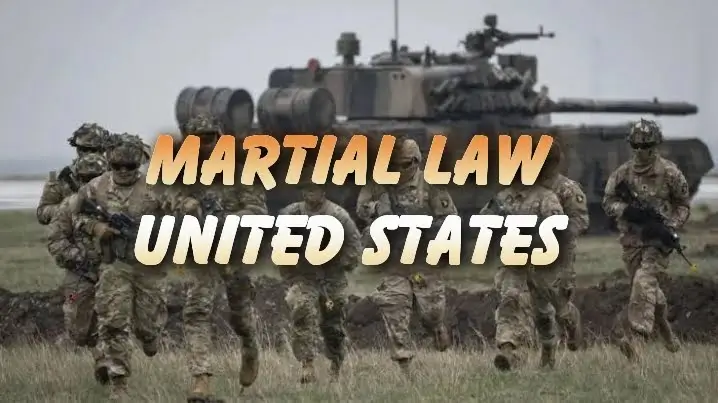Sponsor
Martial law in the United States

Martial law is the replacement of civilian government by military rule and the suspension of civilian legal processes for military powers. Martial law can continue for a specified amount of time, or indefinitely, and standard civil liberties may be suspended for as long as martial law continues. Most often, martial law is declared in times of war or emergencies such as civil unrest and natural disasters. Alternatively, martial law may be declared in the event of a military coup.
Martial law in the United States refers to times in United States history in which a region, state, city, or the whole United States was placed under the control of a military body. On a national level, both the US President and the US Congress have the power, within certain constraints, to impose martial law since both can be in charge of the militia. In nearly every state, the governor has the power to impose martial law within the borders of the state. In the United States, martial law has been used in a limited number of circumstances, such as New Orleans during the Battle of New Orleans; after major disasters, such as the Great Chicago Fire of 1871, the 1906 San Francisco earthquake, or during riots, such as the Omaha race riot of 1919 or the 1920 Lexington riots; local leaders declared martial law to protect themselves from mob violence, such as Nauvoo, Illinois, during the Illinois Mormon War, or Utah during the Utah War; or in response to chaos associated with protests and rioting, such as the 1934 West Coast waterfront strike, in Hawaii after Japan's attack on Pearl Harbor, and during the Civil Rights Movement in response to the Cambridge riot of 1963.
Legal basis
The martial law concept in the United States is closely tied to the right of habeas corpus, which is, in essence, the right to a hearing and trial on lawful imprisonment, or more broadly, the supervision of law enforcement by the judiciary. The ability to suspend habeas corpus is related to the imposition of martial law.[2] Article 1, Section 9 of the US Constitution states, "The Privilege of the Writ of Habeas Corpus shall not be suspended, unless when in Cases of Rebellion or Invasion the public Safety may require it." There have been many instances of the use of the military within the borders of the United States, such as during the Whiskey Rebellion, President Lincoln's suspension of habeas corpus in 1861 in order to arrest of one-third of the Maryland state assembly, and in the South during the Civil Rights Movement, but those acts are not tantamount to a declaration of martial law.[citation needed]
In United States law, martial law is limited by several court decisions that were handed down between the American Civil War and World War II.[citation needed] In 1878, Congress passed the Posse Comitatus Act, which forbids US military involvement in domestic law enforcement without congressional approval.
Throughout history, martial law has been imposed at least 68 times in limited, usually local areas of the United States. Martial law was declared for these reasons: Twice for war or invasion, seven times for domestic war or insurrection, eleven times for riot or civil unrest, 29 times for labor dispute, four times for natural disaster and fifteen times for other reasons. Habeas corpus was suspended federally only once in 1863 during the Civil War.
History
(American Revolution)

Photo source: Wikipedia
The Boston Tea Party prompted Great Britain to pass the Massachusetts Government Act.
During the American Revolutionary period, British authorities imposed martial law in several instances to suppress colonial resistance and maintain control. Notable examples include:
- Boston (1774) — In response to the Boston Tea Party, the British Parliament passed the Intolerable Acts, one of which — the Massachusetts Government Act — effectively placed Boston under martial law by closing its port and restricting town meetings. General Thomas Gage, appointed as the military governor, enforced these measures to quell dissent.
- Virginia (1775) — On November 7, 1775, Lord Dunmore, the royal governor of Virginia, issued a proclamation declaring martial law and offering freedom to indentured servants and enslaved individuals who joined British forces against the rebelling colonists. This move aimed to weaken the colonial rebellion by disrupting the labor force and encouraging enslaved people to support the British cause.
- New York (1776) — Following the British capture of New York City in September 1776, martial law was imposed to restore order and assert British authority. Governor William Tryon, though retaining his title, had limited power as military commanders took control of the city’s administration.
New Orleans in War of 1812
Andrew Jackson imposed martial law in New Orleans during the War of 1812.
During the War of 1812, General Andrew Jackson imposed martial law in New Orleans. Upon arriving in the city on December 1, 1814, Jackson encountered a diverse and divided populace, including Anglo-Americans, Creoles, free people of color, and enslaved individuals. Concerns about potential disloyalty and panic among residents led him to declare martial law on December 16. Jackson imposed several measures:
- Strict curfews and travel restrictions were imposed on all residents. Jackson declared that anyone challenging his authority would be considered a spy or traitor, leading to mass arrests and overcrowded jails. These rules remained in effect for several months after hostilities had ended. When district and federal judges ruled against his actions, Jackson imprisoned them as well.
- Jackson warned newspapers not to publish information about the Treaty of Ghent unless he approved the content. He arrested a prominent legislator and banished several officials for criticizing his heavy-handed enforcement of martial law. Jackson later defended these actions, claiming that unrestricted press freedom could endanger military operations by conveying intelligence to the enemy or inciting unrest.
- Individuals expressing opposition to martial law, including Louisiana State Senator Louis Louaillier and U.S. District Court Judge Dominic A. Hall, were arrested. Louaillier criticized Jackson’s policies in a newspaper article, leading to his arrest on Jackson’s orders. Judge Hall issued a writ of habeas corpus for Louaillier’s release, prompting Jackson to arrest Hall as well.
Nauvoo, Illinois, during the Illinois Mormon War (1843)
In 1843, Missouri sought to extradite Joseph Smith, the founder of Mormonism, for allegedly attempting to murder Missouri governor Lilburn Boggs. He escaped arrest with the help of members of his church, and was discharged on a writ of habeas corpus in the Municipal Court of Nauvoo, where he was mayor, even though it was outside the court's jurisdiction. People in the neighboring town of Carthage, Illinois, felt that Smith was abusing his position in order to avoid arrest. They requested that Governor Ford call out the militia to take Smith into custody, which Governor Ford declined to do.A group of ex-Mormons published a paper called the Nauvoo Expositor which detailed Smith's alleged abuse of power. Together with the Nauvoo City Council, Smith ordered the destruction of the Nauvoo Expositor. This caused an uproar in neighboring towns, which interpreted the order as an attack on the freedom of speech. Smith was charged with causing a riot, which the Nauvoo courts dismissed. Neighboring cities raised money for a militia to go and capture Smith. Governor Ford arrived in Carthage and sent word to Smith that if he did not surrender, Ford would call out the militia. On June 18, Smith declared martial law[20] in Nauvoo and called out the Nauvoo Legion, an organized city militia of about 5,000 men, to protect Nauvoo from outside violence. Ford sent a group of men and abolished martial law. By this time, Smith had escaped into Iowa but was convinced by his supporters to return. He was arrested for treason against the state of Illinois for declaring martial law. While awaiting trial in Carthage Jail, Smith was murdered by a mob. In 1845, Nauvoo was stripped of its charter for abuse of authority. This led to a series of conflicts known as the Illinois Mormon War.
Utah War (1857)
Governor Brigham Young declared martial law on September 15, 1857 in Utah shortly before being removed as governor.
Tension between Utah territory and the federal government was strained in 1857 due to the influence of theodemocracy in Governor Brigham Young's semi-theocratic government, Utah's rejection of federal appointees, and Utah's acceptance of polygamy. In 1857, President James Buchanan sent U.S. forces to the Utah Territory in what became known as the Utah War. The Mormons, fearing that the large U.S. military force had been sent to annihilate them, made preparations for defense. On 15 September, Young publicly declared martial law in Utah. It was widely circulated throughout the territory and was delivered by messenger to Col. Alexander with the approaching army. The most important provision forbade "all armed forces of every description from coming into this Territory, under any pretense whatsoever". It also commanded that "all the forces in said Territory hold themselves in readiness to march at a moment's notice to repel any and all such invasion". But more important to California- and Oregon-bound travelers was the third section that stated, "Martial law is hereby declared to exist in this Territory...and no person shall be allowed to pass or repass into, through or from this territory without a permit from the proper officer." Brigham Young ordered the people in Salt Lake City, Utah, to burn their homes and retreat south to Provo, Utah. Meanwhile, the Mormons harassed the approaching army. Eventually, Brigham Young was removed as governor and replaced by Alfred Cumming.
Baltimore (1861)
In April 1861, secessionists severed railroad links around Baltimore to prevent the passage of federal troops and materiel southward. Union general Benjamin Butler entered the city the following month and took over administration from civilian authorities, despite having no federal authority to do so.







